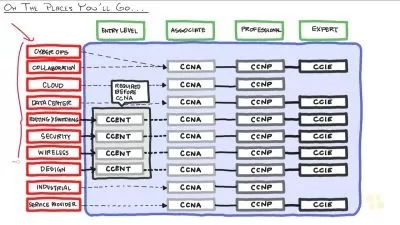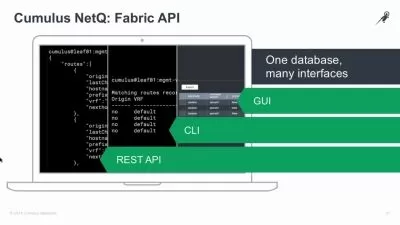CCNA 200-301, 2nd Edition
Focused View
32:35:56
0 View
1.1 Introduction to Routers and Routing Concepts.mp4
35:02
1.2 Introduction to Switching and the Benefits of Switches.mp4
20:51
1.3 Overview of Next-Generation Firewalls, IPS, and Common Placement.mp4
17:58
1.4 Wireless Access Points and the Shift from Wired to Wireless.mp4
43:22
1.5 Controller Concepts and Overview.mp4
21:21
1.6 What Is an Endpoint.mp4
09:28
1.7 Servers, Storage, and Cloud, Oh My!.mp4
13:42
1.8 The OSI Model, Its Importance, and Tying It All Together.mp4
17:29
1.9 Frame or Packet, That IS the Question!.mp4
02:14
2.1 Three-Tier (Hierarchical) Architectures.mp4
05:59
2.2 Two-Tier (Collapsed Core) Architectures.mp4
02:21
2.3 Basic Network Design Concepts.mp4
15:22
2.4 Fabric Components.mp4
09:45
2.5 Wide Area Network (WAN) Concepts.mp4
06:26
2.6 Small OfficeHome Office (SOHO).mp4
03:50
2.7 SaaS and IaaS Infrastructure Models.mp4
08:17
3.1 Single-Mode Fiber (SMF), Multimode Fiber (MMF), Copper (RJ45 and Twisted-Pair).mp4
11:15
3.2 Connections (Ethernet Shared Media and Point-to-Point).mp4
04:15
3.3 Concepts of Power over Ethernet (PoE, PoE+, UPoE, UPoE+).mp4
09:53
4.1 MAC Learning and Aging.mp4
04:51
4.2 Frame Switching.mp4
02:04
4.3 Frame Flooding.mp4
02:10
4.4 MAC Address Table.mp4
02:22
4.5 Switching and Forwarding Lab Walkthrough.mp4
09:46
5.1 Cisco Discovery Protocol.mp4
02:58
5.2 Link Layer Discovery Protocol.mp4
04:49
5.3 CDPLLDP Lab Walkthrough.mp4
13:36
6.1 Access Ports (Data and Voice).mp4
04:55
6.2 Default VLAN.mp4
05:00
6.3 Connectivity.mp4
02:15
6.4 VLANAccess Port Lab Walkthrough.mp4
12:51
7.1 Understanding EtherChannel and EtherChannel Load Balancing.mp4
06:28
7.2 Layer 2 vs Layer 3.mp4
01:54
7.3 Link Aggregation Control Protocol (LACP).mp4
03:52
7.4 EtherChannel Lab Walkthrough.mp4
15:16
8.1 Trunk Ports.mp4
04:34
8.2 802.1Q Trunking Protocol.mp4
07:56
8.3 Native VLAN and Understanding Untagged Traffic.mp4
04:27
8.4 Trunking Overview Lab Walkthrough.mp4
08:25
9.1 Spanning Tree Overview.mp4
07:51
9.2 IEEE vs. Cisco.mp4
10:08
9.3 Spanning Tree Operations.mp4
03:06
9.4 Root Port, Root Bridge (PrimarySecondary).mp4
07:33
9.5 Designated Ports and Alternate Ports.mp4
03:40
9.6 RPVST+ Port States.mp4
02:45
9.7 PortFast Benefits and Examples.mp4
03:49
9.8 Spanning Tree Overview Lab Walkthrough.mp4
27:43
10.1 Collisions.mp4
03:03
10.2 Errors.mp4
05:33
10.3 Mismatch Duplex.mp4
06:14
10.4 Speed.mp4
07:03
10.5 Interface Statistics Lab Walkthrough.mp4
22:31
11.1 TCP.mp4
08:49
11.2 UDP.mp4
06:15
12.1 IPv4 Addressing Overview.mp4
02:32
12.2 Decimal to Binary Conversion Overview.mp4
10:58
12.3 IPv4 Network and Host Addresses.mp4
22:04
12.4 Understanding Broadcast Addresses.mp4
03:41
12.5 RFC1918 Addressing and Usage.mp4
12:18
12.6 How to Calculate Available Subnets and Available Hosts.mp4
09:26
12.7 IPv4 Subnetting Practice Drills.mp4
39:20
12.8 IPv4 Addressing and Subnetting Lab Walkthrough Part 1.mp4
13:39
12.9 IPv4 Addressing and Subnetting Lab Walkthrough Part 2.mp4
01:08
12.10 IPv4 Addressing and Subnetting Lab Walkthrough Part 3.mp4
06:37
13.1 FHRP Overview and Use Cases.mp4
07:01
13.2 HSRP, VRRP, and GLBP Overview.mp4
12:27
13.3 FHRP Routing Lab Walkthrough Part 1.mp4
19:43
13.4 FHRP Routing Lab Walkthrough Part 2.mp4
17:30
14.1 Windows Lab Walkthrough.mp4
03:26
14.2 macOS Lab Walkthrough.mp4
12:35
14.3 Linux Lab Walkthrough.mp4
04:31
15.1 Covering the Bases with RIB, FIB and Destination-based Routing.mp4
03:08
15.2 Prefixes, Routes, Summaries, and Network Masks.mp4
05:46
15.3 Next Hops, Administrative Distance, Metrics, and the Gateway of Last Resort.mp4
14:30
15.4 IP Connectivity Lab Walkthrough Part 1.mp4
25:18
15.5 IP Connectivity Lab Walkthrough Part 2.mp4
10:39
15.6 IP Connectivity Lab Walkthrough Part 3.mp4
09:00
15.7 IP Connectivity Lab Walkthrough Part 4.mp4
14:23
16.1 Longest Match.mp4
05:27
16.2 AD and Routing Protocol Metrics.mp4
06:52
17.1 Default, Network, Host, and Floating Static Routes.mp4
10:25
17.2 IPv4 Static Routing Lab Walkthrough.mp4
12:20
18.1 Neighbor Formation.mp4
08:41
18.2 Network Types.mp4
14:02
18.3 LSAs, Neighbor Adjacencies, and Router ID Significance.mp4
08:31
18.4 Single Area vs. Multi-Area, Flooding and Fault Domains.mp4
17:42
18.5 OSPFv2 Routing Lab Walkthrough Part 1.mp4
14:48
18.6 OSPFv2 Routing Lab Walkthrough Part 2.mp4
18:27
19.1 IPv6 Address Types.mp4
22:55
19.2 Static Routing for IPv6.mp4
03:23
19.3 IPv6 Address Comparison Drills.mp4
15:04
19.4 IPv6 Addressing and Prefix Lab Part 1.mp4
19:45
19.5 IPv6 Addressing and Prefix Lab Part 2.mp4
06:16
19.6 IPv6 Addressing and Prefix Lab Part 3.mp4
18:27
20.1 Typical Wireless Architectures.mp4
10:05
20.2 WLAN Physical Infrastructure Connections and Components.mp4
18:18
20.3 AP Modes.mp4
04:35
20.4 Wireless LAN Controllers.mp4
07:13
20.5 AP and WLC Management Access Connections.mp4
05:39
20.6 FlexConnect and EWC.mp4
08:03
21.1 Wireless Security Protocols (WPA, WPA2, and WPA3).mp4
13:13
21.2 WLC Walkthrough Demo Part 1.mp4
13:08
21.3 WLC Walkthrough Demo Part 2.mp4
13:50
22.1 NAT Translation.mp4
09:10
22.2 Dynamic NAT Configuration.mp4
08:55
22.3 Port Address Translation (PAT).mp4
06:35
22.4 NAT Lab Walkthrough Part 1.mp4
08:34
22.5 NAT Lab Walkthrough Part 2.mp4
06:58
22.6 NAT Lab Walkthrough Part 3.mp4
06:27
23.1 Network Time Accuracy, ClientServer Mode Operations, and Stratum.mp4
15:10
23.2 NTP Lab Walkthrough.mp4
12:25
24.1 DHCP Messages, Operations, Configuration, Client, and Relay.mp4
11:15
24.2 DHCP Lab Walkthrough.mp4
15:43
25.1 Port 53.mp4
01:46
25.2 DNS Functionality.mp4
01:59
26.1 SNMP Use Cases and Benefits.mp4
09:31
26.2 Configuring SNMP.mp4
05:29
26.3 Enabling SNMP Traps.mp4
03:18
26.4 SNMP Walkthrough.mp4
15:39
27.1 Facilities and Levels.mp4
03:19
27.2 Server Configuration, Traps, and the logging buffered Command.mp4
08:20
27.3 SYSLOG Lab Walkthrough.mp4
21:16
28.1 QoS Fundamentals.mp4
42:58
28.2 Per Hop Behavior (PHB) and Drop Probability Explained.mp4
08:52
28.3 QoS Models for Classification.mp4
10:25
28.4 QoS Congestion Management and Avoidance.mp4
21:16
28.5 QoS Lab.mp4
21:12
29.1 SSH Fundamentals.mp4
03:07
29.2 SSH Lab Walkthrough.mp4
15:03
30.1 FTP, SFTP, and TFTP.mp4
04:34
30.2 IP Services Lab Walkthrough.mp4
06:18
31.1 Threats and Vulnerabilities.mp4
10:40
31.2 Mitigation Techniques.mp4
06:58
32.1 User Security Awareness.mp4
05:08
32.2 End User Training.mp4
08:07
32.3 Physical Security and Access Control.mp4
06:45
32.4 Device Access Control Using Local Usernames and Passwords.mp4
13:34
33.1 Password Management.mp4
05:18
33.2 Complexity.mp4
06:31
33.3 Password Alternatives.mp4
05:38
34.1 Remote Access.mp4
05:04
34.2 Site-to-Site VPNs.mp4
11:59
35.1 Standard, Extended, and Named ACLs.mp4
09:29
35.2 ACL Use Cases.mp4
10:50
35.3 ACL Lab Walkthrough.mp4
21:23
36.1 DHCP Snooping and Dynamic ARP Inspection (DAI).mp4
05:20
36.2 Port Security.mp4
08:34
36.3 DAI Lab Walkthrough.mp4
10:51
36.4 Port Security Lab Walkthrough.mp4
15:02
37.1 AAA Overview.mp4
04:03
37.2 AAA Lab Walkthrough.mp4
12:01
38.1 Traditional vs. Controller-based Networks.mp4
07:01
38.2 Northbound and Southbound APIs.mp4
04:29
38.3 Software-Defined Architectures (Overlay, Underlay, and Fabric) Part 1.mp4
23:04
38.4 Software-Defined Architectures (Overlay, Underlay, and Fabric) Part 2.mp4
22:27
38.5 Control Plane, Data Plane, and Management Plane.mp4
08:54
39.1 Inventory, Design, and Provisioning.mp4
14:03
39.2 Device Management and Software Image Management (SWIM).mp4
07:19
39.3 Assurance and Application Policy (QoS).mp4
14:07
39.4 Cisco Catalyst Center Walkthrough Part 1.mp4
19:26
39.5 Cisco Catalyst Center Walkthrough Part 2.mp4
22:16
39.6 Cisco Catalyst Center Walkthrough Part 3.mp4
25:17
40.1 Automation and Network Programmability Overview Part 1.mp4
30:24
40.2 Automation and Network Programmability Overview Part 2.mp4
15:42
40.3 API Fundamentals.mp4
09:03
40.4 CRUD Functions.mp4
06:04
40.5 HTTP Verbs and Response Codes.mp4
19:51
40.6 Data Encoding Formats Part 1.mp4
15:01
40.7 Data Encoding Formats Part 2.mp4
09:21
40.8 On-Box vs. Off-Box Automation Tools.mp4
25:33
40.9 On-Box vs. Off-Box Automation Tools Lab Walkthrough.mp4
23:40
40.10 Introduction to Ansible.mp4
12:36
40.11 Introduction to Terraform.mp4
21:27
CCNA 200-301 Introduction.mp4
01:07
CCNA 200-301 Summary.mp4
00:29
Learning objectives.mp4
00:53
Learning objectives (1).mp4
00:42
Learning objectives (2).mp4
00:35
Learning objectives (3).mp4
00:32
Learning objectives (4).mp4
00:24
Learning objectives (5).mp4
00:31
Learning objectives (6).mp4
00:28
Learning objectives (7).mp4
00:27
Learning objectives (8).mp4
00:46
Learning objectives (9).mp4
00:34
Learning objectives (10).mp4
00:25
Learning objectives (11).mp4
00:53
Learning objectives (12).mp4
00:30
Learning objectives (13).mp4
00:26
Learning objectives (14).mp4
00:33
Learning objectives (15).mp4
00:21
Learning objectives (16).mp4
00:21
Learning objectives (17).mp4
00:34
Learning objectives (18).mp4
00:24
Learning objectives (19).mp4
00:37
Learning objectives (20).mp4
00:25
Learning objectives (21).mp4
00:31
Learning objectives (22).mp4
00:25
Learning objectives (23).mp4
00:23
Learning objectives (24).mp4
00:22
Learning objectives (25).mp4
00:28
Learning objectives (26).mp4
00:28
Learning objectives (27).mp4
00:30
Learning objectives (28).mp4
00:19
Learning objectives (29).mp4
00:22
Learning objectives (30).mp4
00:21
Learning objectives (31).mp4
00:33
Learning objectives (32).mp4
00:20
Learning objectives (33).mp4
00:21
Learning objectives (34).mp4
00:25
Learning objectives (35).mp4
00:25
Learning objectives (36).mp4
00:21
Learning objectives (37).mp4
00:34
Learning objectives (38).mp4
00:30
Learning objectives (39).mp4
00:50
Module Introduction.mp4
00:34
Module Introduction (1).mp4
00:44
Module Introduction (2).mp4
00:46
Module Introduction (3).mp4
00:23
Module Introduction (4).mp4
00:57
Module Introduction (5).mp4
00:40
Module Introduction (6).mp4
00:22
More details
User Reviews
Rating
average 0
Focused display
Category

LiveLessons
View courses LiveLessonsPearson's video training library is an indispensable learning tool for today's competitive job market. Having essential technology training and certifications can open doors for career advancement and life enrichment. We take learning personally. We've published hundreds of up-to-date videos on wide variety of key topics for Professionals and IT Certification candidates. Now you can learn from renowned industry experts from anywhere in the world, without leaving home.
- language english
- Training sessions 222
- duration 32:35:56
- Release Date 2025/01/15








